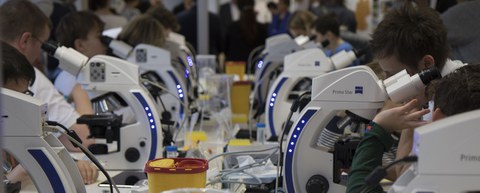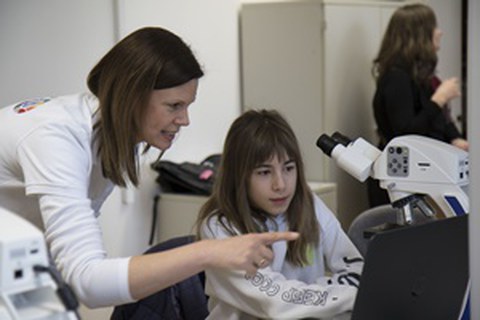Feb 05, 2020
Sugar can glow like a soap bubble - CMCB technology platform supports microscopy courses for children in newly inaugurated digital classroom

Microscopy course in the digital classroom © CMCB
On February 5, 2020, one of the first digital classrooms for microscopy in Saxony was inaugurated. In the presence of State Secretary Andrea Franke from the Saxon State Ministry of Science, Culture and Tourism and the Vice Rector for Education and International Affairs of TU Dresden, Prof. Hans Georg Krauthäuser, children started to use the new microscope facility. This project was led by the team of the Biopolis Dresden Imaging Platform, which also includes the Light Microscopy Core Facility of TU Dresden’s Center for Molecular and Cellular Bioengineering (CMCB) technology platform.
"We want to pass on our enthusiasm for microscopy to children," says Dr. Ruth Hans, staff member of the Light Microscopy Facility, who - like many of her colleagues - gives microscopy courses for children several times a year on a voluntary basis. "We want to offer the kids something exciting, turn them into discoverers and thus win them over to science. Together with the children we answer questions such as 'Why can sugar glow like a soap bubble?', ‘How do cells from our mouth look like when stained with ink?' or 'What is the diameter of a hair?’. It is fascinating to see the children’s excitement about the experiments and how many questions they have after looking into the microscope."
Since 2017, the team is regularly teaching students at the Gymnasium Bürgerwiese – showing them, for example, the otherwise hidden microcosm of tardigrades in moss. This commitment convinced Carl Zeiss AG to donate a classroom set with 15 state-of-the-art microscopes. Each microscope has an integrated HD streaming camera and can be networked with smartphones or tablets. With that, children from all three different secondary school types will have access to powerful microscopy to actively increase their scientific knowledge. Here, physical, biological and chemical contexts can be demonstrated and understood within a few hours. At present, the project team still looks for financing options for the necessary personnel support.
Some more background: The Biopolis Dresden Imaging Platform currently consists of eleven facilities belonging to five different Dresden research institutions. These facilities combine their expertise for the benefit of Dresden scientists. With its approximately 100 instruments, including more than 40 large-scale research devices, the platform covers a broad spectrum of modern imaging technologies. The Biopolis Dresden Imaging Platform was established in 2012 with the support of the German Research Foundation. The project was led by Prof. Michael Brand and is now coordinated by the Light Microscopy Core Facility of the CMCB Technology Platform at TU Dresden.

